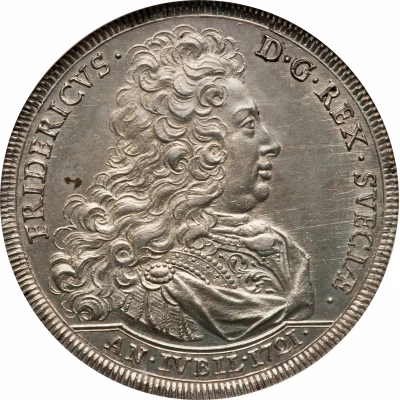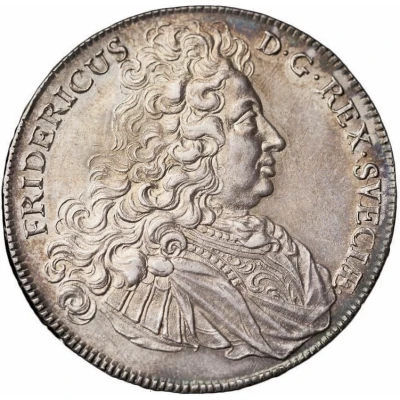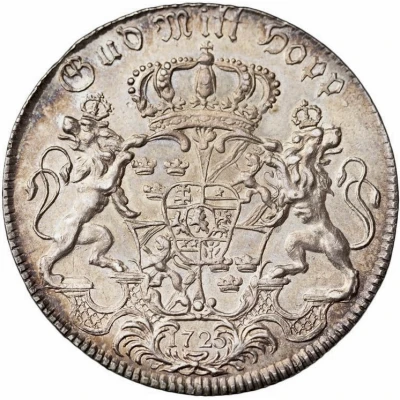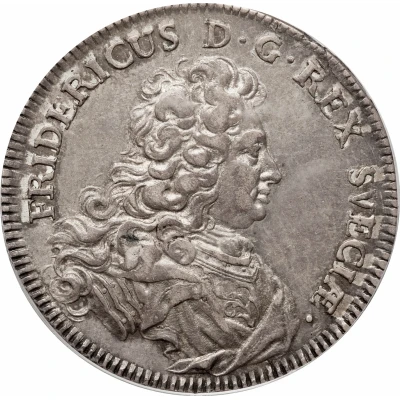
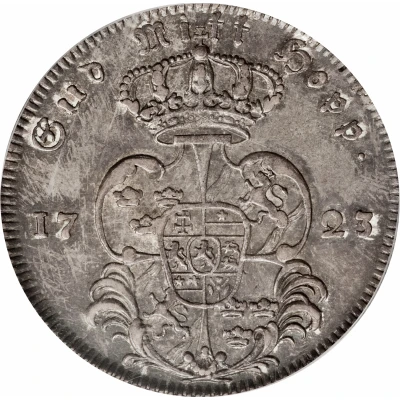

© Heritage Auctions
1 Riksdaler "Krellmynt" - Frederick I 1st portrait
1723 year| Silver (.878) | 29.25 g | 35 mm |
| Issuer | Sweden |
|---|---|
| King | Frederick I (Friedrich I) (1720-1751) |
| Type | Standard circulation coin |
| Year | 1723 |
| Value | 1 Riksdaler |
| Currency | Fourth riksdaler (1719-1798) |
| Composition | Silver (.878) |
| Weight | 29.25 g |
| Diameter | 35 mm |
| Shape | Round |
| Demonetized | Yes |
| Updated | 2024-10-07 |
| Numista | N#107141 |
|---|---|
| Rarity index | 97% |
Reverse
Crowned greater arms of Sweden in ornate shield divides date at sides. Above the crown is the King's motto.
Lettering:
Gud Mitt Hopp .
17 23
Translation: God is my hope
Edge
Smooth with lettering
Lettering: MANIBUS NE LAEDAR AVARIS
Comment
The so-called "Krellmynten" is a series of riksdaler denominations (2, 1 and ½ Rd) from 1723 which was marked in very small mintage. Were used stomps from 1 Riksdaler giving it double thickness to turn into 2 Riksdalers; with same process 1/2 riksdaler stomps became 1 Riksdaler and 1/4 riksdaler stomps 1/2 Riksdaler. The Responsible for the Governor Treasure Paul Krell did it on his own and this prompted receive the blame of Administrative Services Agency. All the krellmynt were retired from circulation and very few survived. Because mintage were so small the Swedish Crown had not suffered any money loss as it sounded, so the matter pass without further actionNOTE: even if this coin has King's first portrait type (armored bust) this portrait is different from those on Mark coins. The main difference is that the bust is more little and the legend i not divided by the bust, but is continuous above it. More the hair and drape folds are totally different as well as King's head.
Interesting fact
The 1 Riksdaler "Krellmynt" coin was minted during the reign of King Frederick I of Sweden, who ruled from 1720 to 1751. The coin's design features the king's portrait on one side and the coat of arms of Sweden on the other. The coin was made of silver and weighed 29.25 grams, which was a significant amount for a circulating coin at the time. The coin's silver content and weight made it a valuable and reliable form of currency, and it was widely used in trade and commerce throughout Sweden and other parts of Europe.
